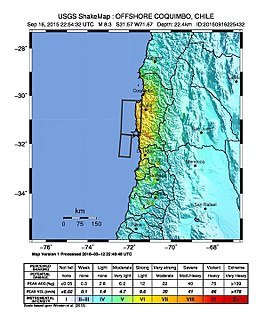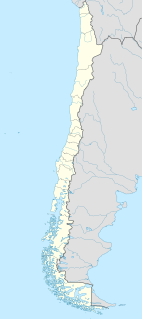 W
WThe 1420 Caldera earthquake shook the southern portion of Atacama Desert on September 1 and caused tsunamis in Chile as well as Hawaii and the towns of Japan. The earthquake is thought to have had a size of 8.8–9.4 Mw. Historical records of the tsunami exists for the Japanese harbours of Kawarago and Aiga where confused residents saw the water recede in the morning of September 1, without any sign of an earthquake. In Chile landslides occurred in the coast as well.
 W
WThe 1835 Concepción earthquake occurred near the neighboring cities of Concepción and Talcahuano in Chile on 20 February at 11:30 local time and has an estimated magnitude of 8.2 Ms or 8.1 ML. The earthquake triggered a tsunami which caused the destruction of Talcahuano. A total of at least 50 people died from the effects of the earthquake and the tsunami. The earthquake caused damage from San Fernando in the north to Osorno in the south. It was felt over a still wider area from Copiapó in the north to the island of Chiloe in the south and as far west as the Juan Fernández Islands.
 W
WThe 1837 Valdivia earthquake struck south-central Chile on November 17. Together with earthquakes in 1575 and 1737 the earthquake is among the historical predecessors to the great 1960 earthquake. The rupture zone was roughly from Valdivia to the south. It was felt in the cities of Concepción, Valdivia and Ancud. The earthquake was also felt by the crew whaling ships in Guafo Island and Chonos Archipelago. Various landslides were triggered in Chiloé and people are reported to have been thrown to the ground in Valdivia. In contrast in Concepción the shakings were moderate. As reported in various coastal localities the ground rose as result of the earthquake. Decades later while surveying southern Chile’s coasts Francisco Vidal Gormaz was told of islands that been submerged and some that had emerged as a consequence of the earthquake. The earthquake caused a tsunami that struck Hawaii, what is now French Polynesia and Japan.
 W
WThe 1960 Valdivia earthquake or the Great Chilean earthquake on 22 May 1960 was the most powerful earthquake ever recorded. Various studies have placed it at 9.4–9.6 on the moment magnitude scale. It occurred in the afternoon, and lasted for approximately 10 minutes. The resulting tsunamis affected southern Chile, Hawaii, Japan, the Philippines, eastern New Zealand, southeast Australia, and the Aleutian Islands.
 W
WThe 1995 Antofagasta earthquake occurred on July 30 at 05:11 UTC with a moment magnitude of 8.0 and a maximum Mercalli intensity of VII. The Antofagasta Region in Chile was affected by a moderate tsunami, with three people killed, 58 or 59 injured, and around 600 homeless. Total damage from the earthquake and tsunami amounted to $1.791 million.
 W
WThe 2010 Chile earthquake occurred off the coast of central Chile on Saturday, 27 February at 03:34 local time, having a magnitude of 8.8 on the moment magnitude scale, with intense shaking lasting for about three minutes. It was felt strongly in six Chilean regions, that together make up about 80 percent of the country's population. According to the United States Geological Survey (USGS) the cities experiencing the strongest shaking—VIII (Severe) on the Mercalli intensity scale (MM)—were Concepción, Arauco, and Coronel. According to Chile's Seismological Service Concepción experienced the strongest shaking at MM IX (Violent). The earthquake was felt in the capital Santiago at MM VII or MM VIII. Tremors were felt in many Argentine cities, including Buenos Aires, Córdoba, Mendoza, and La Rioja. Tremors were felt as far north as the city of Ica in southern Peru.
 W
WThe 2011 earthquake off the Pacific coast of Tōhoku was a magnitude 9.0–9.1 (Mw) undersea megathrust earthquake off the coast of Japan that occurred at 14:46 JST on Friday 11 March 2011, with the epicenter approximately 70 kilometers (43 mi) east of the Oshika Peninsula of Tōhoku and the hypocenter at an underwater depth of approximately 29 km (18 mi).
 W
WThe 2015 Illapel earthquake occurred 46 km (29 mi) offshore from Illapel on September 16 at 19:54:33 Chile Standard Time (22:54:33 UTC), with a moment magnitude of 8.3. The initial quake lasted between three and five minutes; it was followed by several aftershocks greater than magnitude six and two that exceeded 7.0 moment magnitude. The Chilean government reported 15 deaths, 6 missing and thousands of people affected. In Buenos Aires, Argentina, a man died from a stroke while he was evacuating a building.
 W
WThe 2014 Iquique earthquake struck off the coast of Chile on 1 April, with a moment magnitude of 8.2, at 20:46 local time. The epicenter of the earthquake was approximately 95 kilometres (59 mi) northwest of Iquique. The mainshock was preceded by a number of moderate to large shocks and was followed by a large number of moderate to very large aftershocks, including a M7.7 event on 3 April. The megathrust earthquake triggered a tsunami of up to 2.11 metres (6.9 ft) that hit Iquique at 21:05 local time. Similar-sized tsunamis were also reported to have hit the coasts of Pisagua and Arica.
 W
WThis list of earthquakes in Chile includes every known major earthquake that was felt or with its epicenter within Chile's current boundaries.